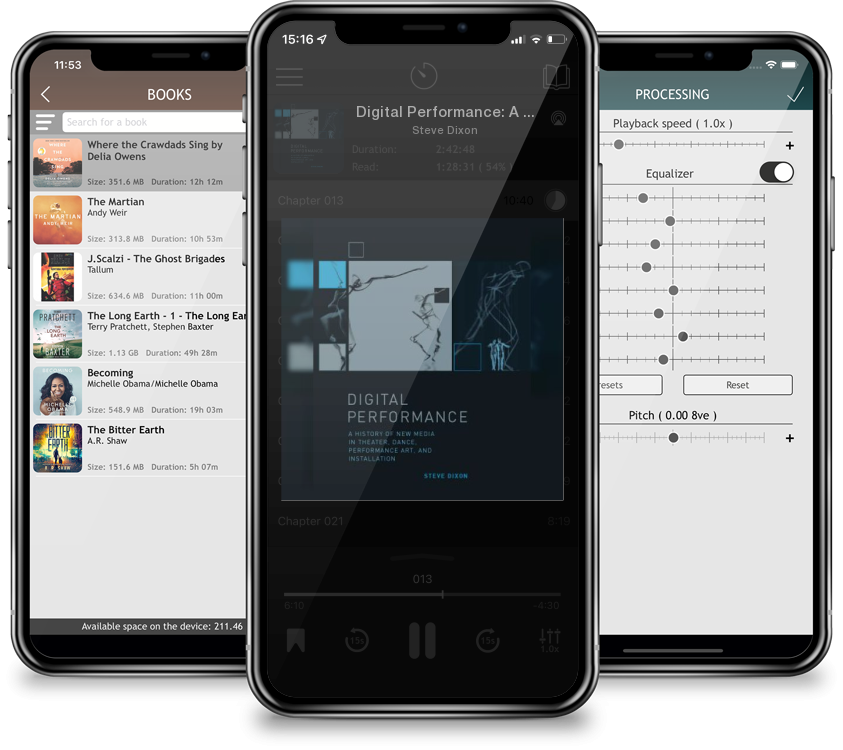Listen to Digital Performance: A History of New Media in Theater, Dance, Performance Art, and Installation (Leonardo Books) by Steve Dixon
Enjoy this audiobook with MP3 Audiobook Player - the ultimate iOS audiobook experience


The historical roots, key practitioners, and artistic, theoretical, and technological trends in the incorporation of new media into the performing arts.The past decade has seen an extraordinarily intense period of experimentation with computer technology within the performing arts. Digital media has been increasingly incorporated into live theater and dance, and new forms of interactive performance have emerged in participatory installations, on CD-ROM, and on the Web. In Digital Performance, Steve Dixon traces the evolution of these practices, presents detailed accounts of key practitioners and performances, and analyzes the theoretical, artistic, and technological contexts of this form of new media art. Dixon finds precursors to today's digital performances in past forms of theatrical technology that range from the deus ex machina of classical Greek drama to Wagner's Gesamtkunstwerk (concept of the total artwork), and draws parallels between contemporary work and the theories and practices of Constructivism, Dada, Surrealism, Expressionism, Futurism, and multimedia pioneers of the twentieth century. For a theoretical perspective on digital performance, Dixon draws on the work of Philip Auslander, Walter Benjamin, Roland Barthes, Jean Baudrillard, and others. To document and analyze contemporary digital performance practice, Dixon considers changes in the representation of the body, space, and time. He considers virtual bodies, avatars, and digital doubles, as well as performances by artists including Stelarc, Robert Lepage, Merce Cunningham, Laurie Anderson, Blast Theory, and Eduardo Kac. He investigates new media's novel approaches to creating theatrical spectacle, including virtual reality and robot performance work, telematic performances in which remote locations are linked in real time, Webcams, and online drama communities, and considers the extratemporal illusion created by some technological theater works. Finally, he defines categories of interactivity, from navigational to participatory and collaborative. Dixon challenges dominant theoretical approaches to digital performance--including what he calls postmodernism's denial of the new--and offers a series of boldly original arguments in their place.
This app has completely transformed my commute – I look forward to it now! Audiobooks have become my companions during daily chores, making them enjoyable. I've never experienced such a smooth audiobook player. The playback is seamless.
This app has added a new layer of enjoyment to my downtime – I'm truly grateful. The app's versatility in downloading audio is impressive. It streamlines the process and saves time. I’m blown away by how feature-rich ListenBook is. From the customizable themes to the car mode, everything is designed with the user in mind. The app works flawlessly, and I’ve had zero issues with crashes or bugs. Highly recommend!
As a visually impaired person, this app has opened up a new world of stories for me. ListenBook's support for a variety of download methods means I can access my content in the way that suits me best. With this app, I've turned mundane tasks into moments of inspiration and education – it's brilliant! ListenBook Pro's noise reduction feature is like a magical spell that transports me into the heart of the story. I've never experienced such silky-smooth playback even with high-quality FLAC files.
Audiobooks have become my go-to gift for friends – and they all love it! With ListenBook, I can explore new genres, learn new topics, and enjoy classic literature with ease. I love the car mode. It’s so convenient for listening while driving. A serviceable audiobook that met basic expectations. The narration was clear if somewhat unremarkable, and the production quality was standard without any noticeable technical issues. It kept me moderately engaged during workouts but didn't leave a lasting impression.
Sharing audiobooks with friends through AirDrop and Sharing on ListenBook Pro is a social audiophile's dream. ListenBook’s playback is silky-smooth. The app never glitches.
With this app, my daily routines have become moments of intellectual exploration and personal growth. 🎧 Audiobooks anywhere, anytime – this app's convenience is unbeatable! 🌟📚 ListenBook Pro's unlimited audiobook length is a dream come true for those epic tales. It's like having a personal audiobook library in your pocket. No more hassle with file conversion. This app handles all formats effortlessly. I'm amazed by the app's compatibility with different audio formats. It's truly versatile.
Plays MP3, MP4, OPUS, OGG, FLAC, AWB, M4B, M4A, WMA, AAC formats
Optimized for iPhone, iPad, and iPod with seamless integration
Adjust playback speed from 0.5x to 3.0x for your listening preference
Import audiobooks via iTunes, cloud services, or direct downloads
Get your favorite audiobooks in supported formats from various sources
Import audiobooks to MP3 Audiobook Player using multiple methods
Control playback from your device, headphones, Apple Watch, or CarPlay
Join thousands of users who enjoy audiobooks with MP3 Audiobook Player daily
Download Now